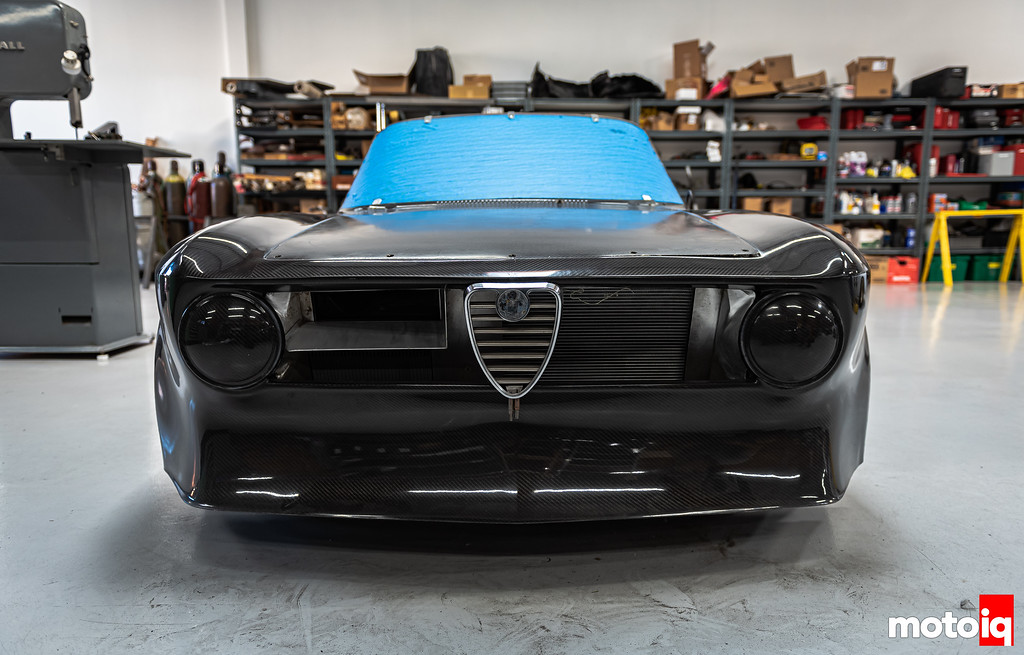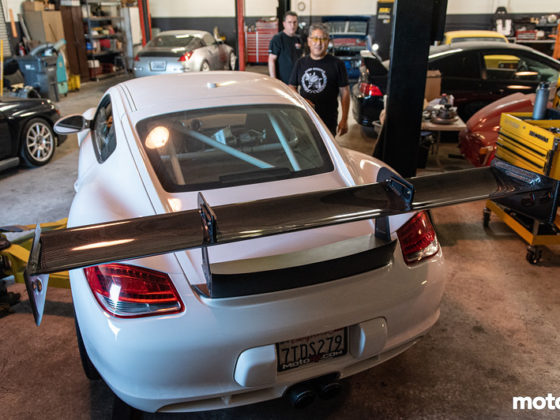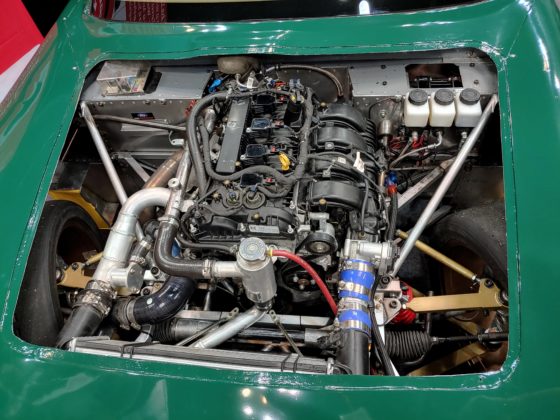
Recently, we got a chance to see a very unique racecar under construction. Our subject car used to be a 1974 Alfa Romeo GTV 2000 GT Veloce. The GTV was a sedan-based sports car, the 105 series chassis family built from 1971 to 1974 for US export. From the factory, the 2 liter, twin-cam, fuel-injected 4 cylinder gave pretty decent performance when coupled to the lightweight body. Alfas like this were popular in racing in the day but have since been far surpassed by more modern cars.
Enter Dino Crescentini. I have known him since I was a kid back during my time at TRD in the ’80s when we used to race against his Alfas in SCCA’s GT3 class with our AE86 Toyota Corollas. Dino’s dad was the owner of Alfa Ricambi, the biggest parts supplier of Alfa parts and he always raced under the Alfa flag. Later Dino went on to be one of the co-founders of Stoptech and that’s how we still have a relationship with him.
Well now in retirement with plenty of time on his hands, Dino set out to build one of the trickiest most insane racing Alfas ever built and we got to get a good look of it under construction. This car is just too cool not to share and it is a crazy blend of retro-modern, perhaps the best of any vintage sort of car we have yet to see. Outlaw 356 builders, eat your heart out, you might get the Instagram likes but you don’t have anything on this build, no sir!

There isn’t much Alfa left of the car anymore. It is built to early 80’s SCCA GT silhouette rules. During this time the SCCA allowed the more prepared GT cars to further differentiate themselves from the unibody-based Production class cars by allowing full tube frames. The roof skin and cowl area had to be from the production car but the rest of the chassis could be tube frame. The reasoning behind this was that tube frames are easier to maintain and prepare. This lead to an explosion of expensive and super-trick cars in the class and this was one of those.

The engine is a 2-liter twin-cam Alfa engine, it has been stroked and resleeved to displace 2100cc. The Alfa engine is pretty unusual, it uses an alloy engine case with free-standing wet cylinder sleeves. This modular block is topped with a twin-plug 2-valve DOHC hemi head. The engine features Carillo rods and CP forged pistons with a 14:1 compression ratio. A lightweight billet marine crank is used for lightness and strength. The crank is 11 lbs lighter than stock. King XP bearings are used for the crank and rods.
The hemispherical two-valve DOHC head features Supertech valves and is extensively ported. The intake ports are welded and raised for better flow. The head also contains custom cams with more lift and duration. The shim and bucket valvetrain has been modified for the cams and high RPM usage.

The engine is set back behind the front axle centerline for a great, mid-engine-like weight distribution. The engine has a large ram airbox with shaped ducts. The airbox when completed will be made of carbon fiber. What you see here is the plug for the carbon fiber mold.

You can see the hand-formed aluminum ducting for the custom PWR radiator and the ram air box. Although the car has crude 70’s aero or lack of aero, the air through the front of the car is managed pretty well.




17 comments
What a treat!!! thanks!!!!
Going to have to dig into this since there’s a lot of cool details and I’m building a GT-3 car too. Trying something new with rear axle location (well, modified Mumford) that has rear roll center around 2″ off the ground and stationary relative to CG… well, it works in CAD, we’ll see in real life.
As alluded to, the Alfa’s gone a bit past GT-3 spec given the displacement. A lot of cool details here, like the weight jackers mentioned. I really like the chassis mounted Watts – the very definition of roll center not moving relative to CG with wheel movement. A lot of guys are using Lotus link rear suspension nowadays, but I really feel like 3 link plus whatever is better. The front suspension is a big series of tradeoffs; it looks like the choice picked here is a bunch of kingpin inclination. With 7 inch wheels and 9-10 inch tires, something has to give. Lovely looking uprights, good looking chassis triangulation, the whole car looks great.
Dan, don’t go that low for your rear roll center. It should also be higher than the front.
Mike, lowest adjustment puts the front at ground level and rear at 2 inches, stationary with respect to CG; they can both go up an inch or two pretty easily. I’ve heard some things from formula car people that it might be interesting to try running that low, but nice thing about tube cars is there’s plenty of scope to build in adjustment. I’m just psyched that I came up with a potentially useful new rear axle location setup.
I would go up for both an inch or two.
Depends on if you will rely heavily on aero or not. The formule guys (I was one of them) use that because they are relatively light and have realativy high downforce. Going that low is only usefull in those circumstances. So I’m with mike on this one.
Suspension in Formula cars is actually more of an afterthought and packaging deal nowadays. At least in F1.
Interesting TB’s built into a DCOE like carb housing. The FI can be tuned on a lap top, and be better controlled. It looks like it was made to be a direct replacement for Webers ( & their fakes), so existing manifolds could be used. Clever Idea!
I put trip weber DCOE’s on a GT6 that I had built, but they were for a larger TR6 engine. I paid almost as much in new parts (6 of each) as I did for the original kit! Initially not much more power, but it made a huge improvement once I modified the engine per Kas Kastner’s Booklet.
Love this build, thanks for sharing. Never knew about those Webber carb-esque ITBs, I’ll have to check those out for my 2002.
@ Mike Kojima:
Tell the owner that by placing copper spacing rings underneath the cylinders and by milling the upper part of sleeve into the cilinder and using a copper headgasket, the cylinders won’t start to walk during very high horsepower applications. Let him look at VW and Porsche aircooled engines. The cars where actually made with a turbo from the factory later in life in the Alfa 75. Really cool build!
One thing I’m wondering though: Why not use the transaxle used in a lot of alfa’s with inboard disc brakes? The alfa 75 being just an example?
GT-3 rules say the trans front seal has to be within 12″ of the engine rear main seal. Car might be a little past GT-3 rules in the engine department as presented in the article, but the rest of it seems like it’s still GT-3.
A right, that explains a lot! But does that also apply to cars that standard come equiped with a transaxle? As I said, the Alfa 75 came with the same engine and the transaxle with inboard disc brakes on all variants.
SCCA classes have kind of “baseline assumptions” of what the intent is for something in that class – except for some classes that turned into “catch all” classes where they lump stuff in that makes broadly similar lap time in a broadly similar way. So one class “down” in Production, the “baseline assumption” is that you’ve got a heavily modified unibody car with maybe widebody and stuff, and slicks of a given size and such and such power to weight, and the stock gearbox or something with a gear kit in it if you accept the minimum weight penalty. There, the “rear transaxle is how it came stock” is totally game because hey, you’re probably running the stock driveline or something close, and a few enthusiast cars did that. GT the assumption is that it’s a silhouette car with basically nothing stock anyway and they don’t want to give drivetrain allowances for specific cars.
Now, all of this aside, an important context is that most of the SCCA GT class cars are _actually_ ex-various-pro-class cars; most of the current GT-3 field was Nasport (I think Mike might know more about that) and before that was often more heavily modified IMSA RS cars, GT-2 (before it turned into a catch-all) was basically IMSA GTU or GTS-3 cars, and GT-1 is basically Trans Am stuff. So some of the build configuration stuff is holdovers from that and nobody really wants to get into a major development arms race. Usually if you show up with an existing car that was built to a different rules set but is similar they’ll write a place for you in the rule book (the Grand Am tube chassis RX-8 with a rear transaxle got a spec line in GT-2 for example) but a new build car I don’t think anyone would be sympathetic to going past the established stuff.
Totally different compaired to FIA regulated events where I’m familliar with. Over here it’s: Not in the rulebook? Not allowed. But in essence tje GT3 class over there is kind of spec class, where over here it is a production based racing class that are homologated for racing in the class.
Yeah, no relation between the two GT3 classes; it all falls down to SCCA is a club that people join to go racing and theoretically is directly answerable to the people racing, whereas the FIA isn’t. It’s a sanctioning body but not pro racing.
Worth mentioning though that FIA GT3 cars are eligible to run in SCCA GT-1, albeit mostly because people who own the cars asked. Don’t know that they’d be competitive at the big tracks though, but they’re legal. Almost any ex-Pro or Pro-who’s-running-for-fun stuff GT3 or slower is eligible somewhere in SCCA if they ask.
Does anybody know who actually engineered and built this? Dino?
A bunch of people, a lot of credit goes to Steve Ruiz and his son.
Steve, Dino and Mike?
DREAM TEAM!